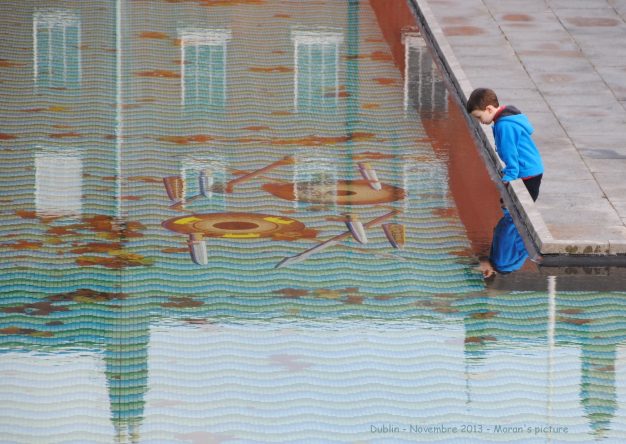
Everyday smells, sights and sounds of children in the city
Building genuinely child friendly cities must begin with an appreciation of the child’s own daily perspective on their built environment, argues Jackie Bourke. Here, she describes how her research with inner city children in the Republic of Ireland capital, Dublin opened a window on the sensory and imaginative richness of children’s ‘everyday walks through a complex urban landscape of belonging’.
Increased attention to meeting children’s needs is an encouraging shift in urban planning, with models like the UNICEF Child Friendly Cities and Communities Initiative supporting cities to move in this direction. Dublin City is among those taking the first steps towards achieving child friendly status, with an initial focus on creating a playful city.
The urban public realm is of course not only a potential site of play for children and young people. Much like adults, they use public space to go to the shop, access amenities, visit friends and family and make the trip to and from school. A key question underpinning efforts to ensure cities are child friendly is how they experience these everyday journeys.
Research undertaken by the author, with 9-11 year olds based in Dublin, suggests it is a very rich and varied experience. Twenty children participated in the study, all of whom live in the North West Inner City. This part of Dublin has a diverse built environment; ponies kept down small cobbled laneways contrast with heavily trafficked arterial routes, bringing commuters in and out of the city.
… they describe journeys through an urban landscape at once social, sensory, imaginative and pragmatic.
The children who participated in the study all walk to school on a regular basis. As part of the research the children photographed their routes and captured their experience. Through their images they described journeys through an urban landscape at once social, sensory, imaginative and pragmatic.
 Their social interactions with local shop keepers, business owners and neighbours are much treasured. Through small daily exchanges the children foster social capital and help knit the community together. Their experience is an embodied one and the children capture a range of sensory moments on their walks: they see and appreciate the aesthetic detail of buildings they pass, and describe the sounds of the city that gives texture to their walk: from the daunting clang of the tram, to the roar of traffic drowning out their conversations.
Their social interactions with local shop keepers, business owners and neighbours are much treasured. Through small daily exchanges the children foster social capital and help knit the community together. Their experience is an embodied one and the children capture a range of sensory moments on their walks: they see and appreciate the aesthetic detail of buildings they pass, and describe the sounds of the city that gives texture to their walk: from the daunting clang of the tram, to the roar of traffic drowning out their conversations.
Sensory experience
Certain smells are evocative, particularly for the children who walk by the old fruit and vegetable market each day. Their sensory experience is also quite tactile and they described both the hard feel of the footpath beneath their feet and the more gentle touch of the sunshine on a warm sunny day.
At the same time the children mapped out an imaginative experience. They identified haunted houses, a visitors’ centre where, apparently, a broken lift has left a number of tourists stranded for several years, and even a forest of trees “full of life” hidden behind a high wall. Inevitably there was a pragmatic dimension to these walks and the children were quick to point to the challenges presented by the high volume of traffic. Equally, poorly designed spaces, neglect, decay, dereliction and rubbish must be navigated on their routes.
The childhood landscape of the urban public realm revealed through this study is rich and complex, both inviting and hostile, and it sheds valuable light on the city world children that inhabit and shape. This kind of insight into children’s everyday lives is an important starting point on the journey towards creating a genuinely child friendly city.
Jackie Bourke
Main photo: Moran Rencontre le Monde
Inset photo: From children’s photographs of their city walks, made for the study.
Further information on the study referred to in this article can be found here




